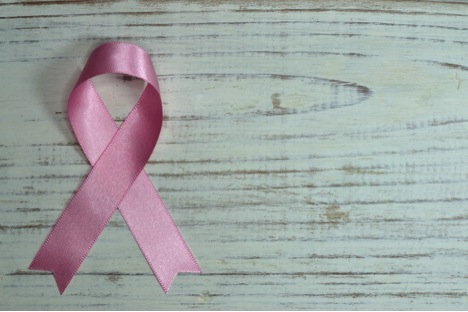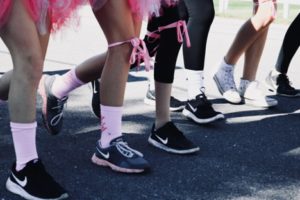
Breast Cancer Awareness Month: The story of the pink ribbon and a resilient movement
Front Page October 27, 2019, Comments Off 203With football season in full swing, an October signature of many team uniforms is a pink accessory, be it socks, shoes or a special jersey variation. Fundraisers and events happen on a global scale with local and campus support as well.
Breastcancer.org cites that, aside from lung cancer, breast cancer kills more than any other type of cancer. Approximately 12 percent of women in the United States will develop invasive breast cancer within their lifetime. However, breast cancer-related deaths have been declining since 2002, especially for women under the age of 50.
Breast cancer has become a worldwide rallying cry. But how did it reach that point?
The pink ribbon
In 1985, the United States established national recognition for breast cancer awareness, although it began as only a week instead of a month.
Before that, in their “Pink Ribbon Story” publication, the Susan G. Komen for the Cure Foundation states that it has been using the color pink in association with breast cancer awareness since 1982.
It would not be until the 1990s when the pink ribbon would explode on the scene, though. In 1992, the New York Times went as far as to say that 1992 was the “Year of the Ribbon” as more causes adopted it. This was not the first use of ribbons as awareness tools. The AIDS demonstrations of the 1980s led the charge to bring about ribbons in the mainstream as we know them today, taking the yellow ribbon that originated as a result of the 1978 Iran Hostage Crisis and turning it bright red. The Think Before You Pink website traces the history of the ribbon and its evolution over time, noting that it would not be until the “ribbon was the event” rather than a passing symbol that it would catch on.
This event came in 1992 with Alexandra Penney, a New York-based photographer and the editor in chief of Self magazine. Penney wanted to improve upon the magazine’s breast cancer issue from the year before and sought to develop a symbol that would propel that. She turned to Charlotte Haley.
Haley is credited for creating the original peach-colored ribbon. She operated as an individual non-profit, selling her ribbons in packs of five with a message included about the lack of funding for breast cancer research from the National Cancer Institute.
While Penney contacted Haley to incorporate the ribbon into their magazine campaign, Haley refused. She believed the motive was too commercial. To get around infringing on Haley’s design, Self selected pink as its ribbon color instead. The shade “150 pink” was selected, and it was made in the grosgrain ribbon style, which was a thicker, cord-like fabric. It was so successful that the pink ribbon sufficiently outpaced Haley.
The message of “think before you pink”
The pink ribbon’s rapid rise is linked to the “safe” nature of supporting breast cancer awareness. Whereas AIDS was a highly controversial topic, breast cancer was considered a “lifestyle issue” according to Carol Cone, a founder of Cone Communications and one of the people who marketed the pink ribbon into an international phenomenon.
The money that companies make off of their awareness campaign is not entirely negative: it does ensure the ribbon and its meaning are plastered on clothing, jewelry and NFL teams across the nation. However, it also contributes to the commercialization of the movement – and the hypocrisy of toxin-laden products.
Breast cancer awareness has become a commodity in a similar fashion of the “rainbow capitalism” that pops up every June as companies plaster pride flags on their logos and merchandise.
Think Before You Pink and Pink Ribbon International are organizations determined to take on companies that use chemicals known to cause breast cancer. This is known as “pinkwashing,” another term shared with the LGBTQ+ community that represents the corporate mask of support for both groups without any substantial fundraising or policy change.
Estee Lauder and Avon, two of the cosmetics companies associated with the kickoff of breast cancer awareness, have been accused of pinkwashing. Think Before You Pink ran a campaign, “K[Not] Our Pink Ribbon,” in part against Estee Lauder for its use of the ribbon without providing much support for the movement outside of the image.
Baker Hughes, an energy services firm, faced backlash in 2014 when it announced that donations to the Komen fund were matched by painting drill bits used for fracking pink. Fracking releases carcinogenic chemicals linked to breast cancer. Other companies under fire include Ford Motor Co., KFC (for its infamous chicken breast campaign) and New Balance sneakers.
The Springfield impact and on-campus philanthropy

On Oct. 19, the American Cancer Association sponsored the Making Strides of Southwest MO event through the downtown area. Walkers decked out in pink maneuvered their way down St. Louis St. to Hammons Field. Another event will be held from 7:30 to 9 a.m. on Sunday, Oct. 27, again at Hammons Field. The Breast Cancer Foundation of the Ozarks is another sponsor of the events.
Drury is making a difference too. Zeta Tau Alpha’s national philanthropy is breast cancer education and awareness, which includes raising funds to fight breast cancer. They put on many events throughout the year including various dine-outs at restaurants, lemonade stands on the first Wednesday of every month and, in the spring semester, Big Man on Campus. Queso for a Cure is the one that falls within Breast Cancer Awareness Month.
“The funds that we raise go to the Zeta Tau Alpha Foundation, who then distributes the funds to our partners, Think Pink, Bright Pink, and the American Cancer Society,” said Savannah Peshek, the sorority’s philanthropy chair. “Think Pink is dedicated to the awareness aspect of our philanthropy, Bright Pink sponsors educational workshops around the country to teach women how to detect and prevent breast cancer and lastly, the American Cancer Society is devoted to support of survivors.”
Queso for a Cure begins at 6 p.m. and goes until 8 p.m. on Wednesday, Oct. 30 in the FSC Ballroom. It costs $25 to form a team to make queso. To eat queso and support the cause, it is $5 for a ticket in advance and $7 at the door.
“Queso for a Cure is an event where different teams make queso, and then the public attends the event and can try the different queso. We then give awards out for Best Queso and Worst Queso,” said Peshek.
“I think Queso for a Cure is a really great event that Zeta puts on every year,” said sophomore Julie Williams. “I think it’s really important in the community to be aware. I feel like it can be taboo sometimes to talk about it because it’s ‘breast cancer,’ and people—including guys—will say that they’re fine because it won’t happen to them. Nobody assumes that they’ll get cancer, but taking steps to identify signs ahead of time is important for everyone. And the more that everybody knows, the less we have to feel awkward about.”
“Queso for a Cure helps make the Drury community more aware of the devastation while enjoying queso and bonding and coming together as a community,” said sophomore Ali Altahafi. “ZTA has always done a great job and received high turnout. Queso for a Cure boosts (cancer patients’) confidence knowing there are people supporting and cheering them on.”
Screenings and prevention
While breast cancer may occur with any gender, it is most commonly diagnosed in cisgender women. According to Breastcancer.org, gender and aging are the two biggest risk factors for breast cancer, as most individuals are diagnosed later in life as a result of genetic mutations that are not inherited. However, a woman’s risk of breast cancer doubles if her mother, daughter or sister receives a diagnosis.
Breast Cancer Foundation of the Ozarks offers free mammograms to those who complete an application and have medical care through contracted hospitals and facilities, and they advertise their services to the “uninsured and underinsured.” Planned Parenthood offers screening services as well, alongside Mercy and Cox hospitals.
It is recommended that women 40 and older get a mammogram once a year, but it is encouraged for everyone to do self-screenings to check for lumps or abnormalities often.
Article by Maclen Johnson and Ryan Smith